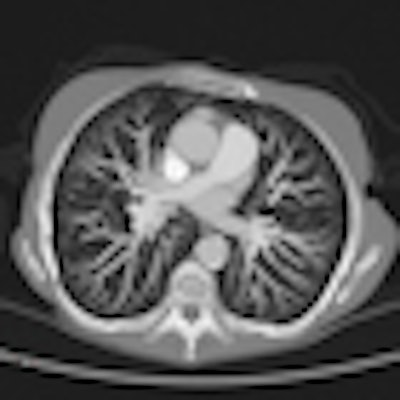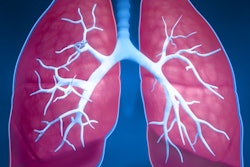
Clinically insignificant pulmonary emboli (PE) are overdiagnosed by CT and then overtreated with anticoagulants, concludes an editorial published this week in the British Medical Journal (BMJ). Today's CT scanners are doing a great job of finding the smallest clots, but patients are more at risk than ever from unnecessary treatment, the authors warned.
In the past two decades, high-resolution CT has evolved to the point where it can detect the smallest filling defects, even blockages as small as 2-3 mm of the subsegmental arteries, wrote Dr. Renda Soylemez Wiener and colleagues. Since about 2005, CT has become the de-facto gold standard for ruling out PE, wrote the authors from Boston University School of Medicine, ENRM VA Hospital in Bedford, Massachusetts, and Dartmouth Medical School in Lebanon, New Hampshire. But new evidence shows a greater risk of death from treatment, not small PE, they wrote.
"Pulmonary embolism is unquestionably an important cause of death, and rapid diagnosis and treatment can be lifesaving," wrote Wiener and colleagues Lisa Schwartz and Steven Woloshin. "But the diagnostic zeal and technological advances meant to improve outcomes of patients with pulmonary embolism are double-edged swords: Some patients are helped, but many are harmed through overdiagnosis and overtreatment."
Fewer treated, fewer complications
It wasn't always so. Until recently, ventilation-perfusion (VQ) scanning, introduced in the mid-1960s, was the first-line test for pulmonary embolism, and clinicians maintained high standards for the use of invasive pulmonary angiography. But VQ scans were less sensitive than multidetector CT (MDCT), introduced in the 1990s, often producing inconclusive results.
But CT became part of the explosion in CT scans in the new millennium, becoming the first-line choice for imaging suspected PE, they said. Data from health maintenance organizations underscores this trend. The use of use of CT pulmonary angiography rose 14-fold -- from 0.3 to 4.0 beneficiaries per 1,000 from 2001 to 2008, while the use of VQ scanning fell by 52% (from 2.3 to 1.1 per 1,000 beneficiaries) during the same time period, the authors reported.
Another advantage of CT angiography (CTA) is that it allows clinicians to find other causes for the nonspecific symptoms, such as pleural effusion or pneumonia, which brought the patient to seek care. But the main reason for CTA's popularity is its ability to find the "silent killer," Wiener and colleagues wrote.
"With more testing, more pulmonary emboli are found," the authors wrote. "These extra diagnoses lead to testing even more patients because of the pervasive belief that finding even a tiny, subsegmental pulmonary embolism means you may have saved a life. Case finding has also increased as a result of the widespread use of nonspecific blood tests such as D-dimer and troponin, which raise suspicion of pulmonary embolism (and imaging to look for it) in patients in whom it would not otherwise have been considered."
Meanwhile, MDCT equipment manufacturers have joined the battle, selling hospitals the most advanced equipment to help them establish themselves as being on the cutting edge of clinical care, Wiener et al wrote. Finally, pharmaceutical firms have launched deep vein thrombosis (DVT) and PE awareness campaigns, which have brought in more patients.
Likely overdiagnosis
With CT finding filling defects in subsegmental arteries as small as 2-3 cm, positive results are running at around 15% of all CT scans, versus 1% "high probability" VQ scans, the authors wrote. Finding so many positive cases would be a great thing if small PE were harmful, but the evidence suggests they are not.
"It has been argued that a normal function of the lungs is to act as a sieve to prevent small emboli formed in leg veins from traveling to the systemic arterial circulation with devastating effect, such as stroke," they wrote. "These emboli are believed to be resorbed by the body without treatment and to have no clinical effect."
Studies of CTA performed for other reasons bear out the theory that small emboli are not harmful: Incidental PE were found in 16% of mechanically ventilated patients, in 17% of patients older than 80, and in 20% of trauma patients, the authors wrote. More than half of autopsies in a series were found to have incidental PE.
Donato et al looked at outcomes in 192 patients with isolated subsegmental emboli found in the literature; among the 65 who did not receive anticoagulants none had a recurrence of PE or death, and only one of 127 patients who received anticoagulation had a recurrent and nonfatal PE, a much lower recurrence rate than seen with large clots.
Finally, a trial by Anderson et al that randomized 1,417 patients with an intermediate to high probability of pulmonary embolism to receive VQ scanning or CT pulmonary angiography found that CT detected more PE (19.2%) than the VQ scans did (14.2%, p = 0.01), but the researchers found no difference in death from PE or other unknown causes.
"Definitive evidence of overdiagnosis would, of course, be the finding that untreated patients never experienced harm from the pulmonary embolism during the rest of their lives and died from another cause, but no such studies exist," Wiener et al wrote.
On the other hand, anticoagulation therapy is a leading cause of medication-related death, they wrote, and some studies have shown complications of anticoagulation to be more common than recurrent venous thromboembolism.
In a series of 93 patients given anticoagulants for isolated subsegmental PE, the risk of major bleeding was 5.3% versus the risk of recurrent venous thromboembolism of 0.7%, they wrote. In their own study, the authors found presumed anticoagulation complications rose from 3.1 to 5.3 (p < 0.001) per 100,000 patients admitted between 1998 and 2006.
Overdiagnosis and overtreatment are also costly to health systems, with mean charges of $25,000 U.S. (19,270 euros) per PE admission, in addition to nearly $3,000 (2,312 euros) for lab tests and clinic visits. And the newest drugs can cost as much as $3,000 per year versus $48 (37 euros) a year for Warfarin, the group noted. Eliminating CT scans for suspected PE would also avoid the dose of radiation and nephrotoxic agents associated with a CT scan.
Doing less with less
In stable patients, using less-sensitive VQ as the first-line scan in patients with normal appearing chest radiographs could reduce the death toll from PE without the harms of overdiagnosis, they wrote.
Some authors have suggested withholding anticoagulation for stable patients with isolated subsegmental pulmonary embolism and adequate cardiopulmonary reserve, they wrote. However, they cautioned, patients who are not treated should be monitored for new respiratory symptoms and DVT with serial ultrasonography for three to six months to determine whether anticoagulation can be safely withheld. As yet unanswered questions include those surrounding the natural course of symptomatic versus asymptomatic PE, the authors noted.
"[S]ome patients are helped, but many are harmed through overdiagnosis and overtreatment," Wiener and colleagues concluded. "The idea that pulmonary embolism can be overdiagnosed will be new and counterintuitive for some clinicians, but the harms are just as real as those of underdiagnosis. To improve outcomes for all patients, we need to learn more about which small emboli need treatment."
To that end, an ongoing prospective cohort study is looking at the safety of withholding treatment for stable patients, they wrote.
Editor's Note: In the image on our home page, the Ingenuity CT system with iDose demonstrates good contrast resolution and visualization of small vascular structures out to the peripheral lung. Image acquired in 6 seconds and reconstructed in 39 seconds. Other scan parameters: 80 kVp, 0.9 mSv, 138 mAs, 32 cm scan length. Image courtesy of Philips Healthcare.


















